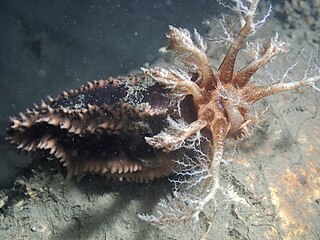
Priapulida, sometimes referred to as penis worms, is a phylum of unsegmented marine worms. The name of the phylum relates to the Greek god of fertility, because their general shape and their extensible spiny introvert (eversible) proboscis may resemble the shape of a human penis. They live in the mud and in comparatively shallow waters up to 90 metres (295 ft) deep. Some species show a remarkable tolerance for hydrogen sulfide, anoxia and low salinity. Halicryptus spinulosus appears to prefer brackish shallow waters. They can be quite abundant in some areas. In an Alaskan bay as many as 85 adult individuals of Priapulus caudatus per square meter has been recorded, while the density of its larvae can be as high as 58,000 per square meter.

Sir John Murray was a pioneering Canadian-born British oceanographer, marine biologist and limnologist. He is considered to be the father of modern oceanography.

Apodida is an order of littoral to deep-sea, largely infaunal holothurians, sea cucumbers. This order comprises three families, 32 genera and about 270 known species, called apodids, "without feet".

Holothuria is the type genus of the marine animal family Holothuriidae, part of the class Holothuroidea, commonly known as sea cucumbers. Members of the genus are found in coastal waters in tropical and temperate regions. They are soft-bodied, limbless invertebrates which dwell on the ocean floor and are usually detritivores. They resemble a cucumber in form. The genus contains some species that are harvested and sold as food.

Cucumaria is a genus of sea cucumbers.

Apostichopus is a genus of sea cucumbers in the family Stichopodidae.

Elasipodida is an order of sea cucumbers. They have numerous appendages, including conical papillae and leaf-like tentacles. Although many species are benthic, a number are pelagic, and may have their appendages modified to form sails or fins. Most members of the order inhabit deep-sea environments, such as the species of the genus Enypniastes.

Psychropotes is a genus of sea cucumbers in the family Psychropotidae. The members of this genus possess the ability to swim, although this is only facultative.

Ocnus is a genus of sea cucumbers in the family Cucumariidae.

Elpidia is a genus of deep-sea sea cucumbers. Members are characterised by their rod-shaped spicules which each have two pairs of obliquely placed horizontal arms and two vertical apophyses. There is a high degree of endemism in this genus with different species occupying different deep sea basins or regions.

Peniagone is a genus of deep-sea sea cucumbers in the family Elpidiidae. Peniagone wyvillii is the type species.

Psolus is a genus of sea cucumbers in the family Psolidae, marine animals with long bodies, leathery skins and tentacles, that inhabit the sea bed.

Benthodytes is a genus of sea cucumbers in the family Psychropotidae.

Thyone is a genus of sea cucumbers in the family Phyllophoridae.

Mesothuria is a genus of sea cucumbers belonging to the family Mesothuriidae. The genus has a cosmopolitan distribution.

Mesothuriidae is a family of echinoderms belonging to the order Holothuriida.
Molpadiodemas is a genus of sea cucumbers belonging to the monotypic family Molpadiodemidae. The genus has an almost cosmopolitan distribution.

Pseudostichopus is a genus of sea cucumbers belonging to the monotypic family Pseudostichopodidae. The genus has a cosmopolitan distribution.
Aslia is a genus of echinoderms belonging to the family Cucumariidae.

Synallactes is a genus of sea cucumbers in the family Synallactidae. The type species of this genus is Synallactes alexandri.

















